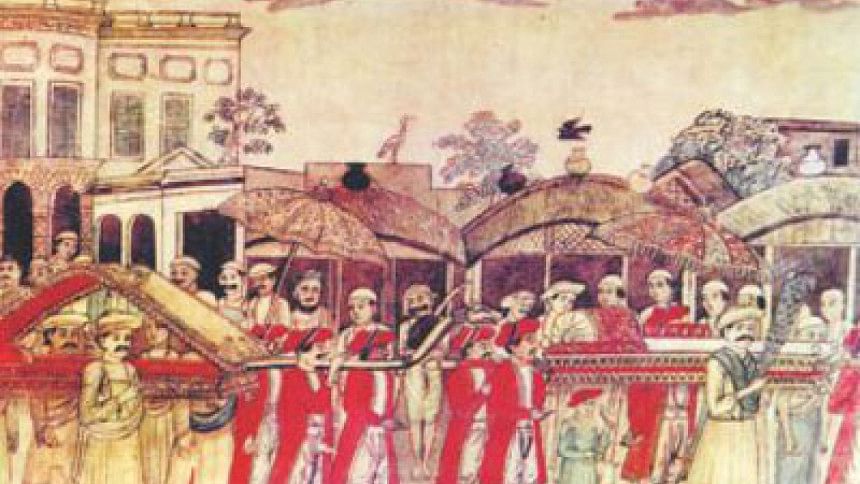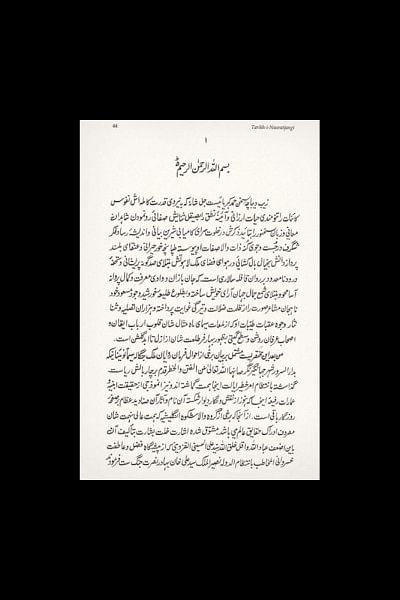MAN AND HIS MANUSCRIPT

He was a sophisticated man - of letters and of fine arts. In fact, it had been reported by Charles D'Oyly, a public official and a painter, that "...his audience chamber is so crowded with English prints and paintings that not an inch of the walls can be seen."
Nawab Nusrat Jung was the longest serving Naib Nazim in Dhaka, holding the post for over three decades, from 1785 to 1822. He was regarded as a very cultured and respected ruler.
However, there is enough room to question the extent of his influence. Behind the splendour, the truth lay that the British had by then become the rulers and that the seat of Naib Nazim enjoyed little authority.
At the request of some of his English acquaintances, Nusrat Jung had written an account of Dhaka, called 'Tarikh-i-Nusratjangi: Risala Darbayan-i-Ahwal-i-Jahangir Nagar, Dhaka'. Today, the Persian account is a firsthand source of information for those interested in the history of this city.

But not everyone is, or was, a fan of this treatise. As orientalist Henry Ferdinand Blochmann (1838-1878) said, "The book is good for nothing. The history of Dacca is written in the last two leaves. The other leaves contain the history of Bengal, but most facts are wrong and nothing is new."
So does it mean that we should shove this book away?
Not at all. In fact, Tarikh-i-Nusratjangi has been translated in English and published by Asiatic Society of Bangladesh. Sharif uddin Ahmed is the general editor of the book. The project has been initiated and funded by The Mahbub Alam and Jahanara Majid Trust Fund of Asiatic Society of Bangladesh.
Abdus Sobhan, text editor and translator, wrote, "Blochmann's surmise can at best be dismissed as a very casual and loose statement. Much of what has been recorded by the author may be unpalatable and, at times, may appear scandalous, but they should be accepted as genuine observations of an eye witness chronicler..."
Asiatic Society's publication can be divided into three sections: the translation, the original text in Persian and lastly a chapter about Naib Nazims. The entire book is only 105 pages; it is a quick read indeed.
Tarikh-i-Nusratjangi starts to describe the history of Dhaka from the time of Mughal invasion. Keeping accounts brief, it talks about many Mughal rulers of this land - Islam Khan, Mir Jumla, Sirajuddowla, etc.
Eventually, it comes down to a point where it talks about the writer himself: "... the authorities of the East India Company, having due regard for loyalties and services of my family displayed earlier, I was appointed subahdar of Jahangir Nagar..."
Then, in the very next paragraph, he is referred to as 'Late' Nawab Nusrat Jung! This marks the death of the Naib Nazim.
The pen fell upon Syed Abdul Ghani, who humbly introduced himself as "lowliest of slaves" and the son of Nusrat Jung's Head of Army. The chronicle then narrates stories of latter Naib Nazims - the decline of power, their financial problems and their miseries.
Nusrat Jung has come down today as a revered figure. "On the day he passed away," Abdul Ghani wrote dramatically, "there occurred such a hue and cry, as it would seem that the Day of Judgement had arrived. Many Hindus, Muslims and English residents were afflicted with grief..."
Today, the man lies buried in the premises of Hussaini Dalan, but through his work, Tarikh-i-Nusratjangi, he continues to live forever.

 For all latest news, follow The Daily Star's Google News channel.
For all latest news, follow The Daily Star's Google News channel. 



Comments